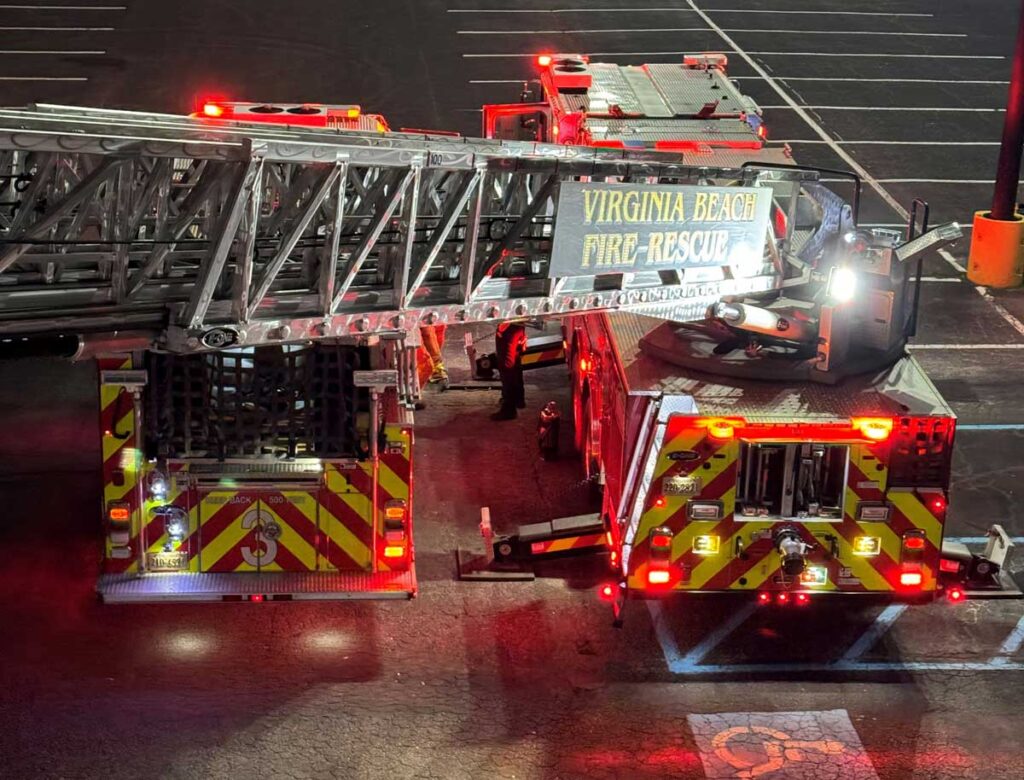
By Joseph M. Rock
All photos by author
A parapet is a free-standing barrier that is an upward extension of a wall at the edge of a roof. In ancient times, parapets were originally used as defense from enemy military attacks. Modern-day commercial building parapets are used for aesthetics, fall protection, wind force reduction, and reduction of fire spread. Parapets aid in fire spread reduction by preventing vertical flame spread and act as a blockade to radiant heat transfer from building to building.
- Parapet Preparedness
- The Problematic Parapet
- Construction Concerns for Firefighters: Cornices and Parapets
- Parapet Collapse: An Old Danger for Today’s Firefighters
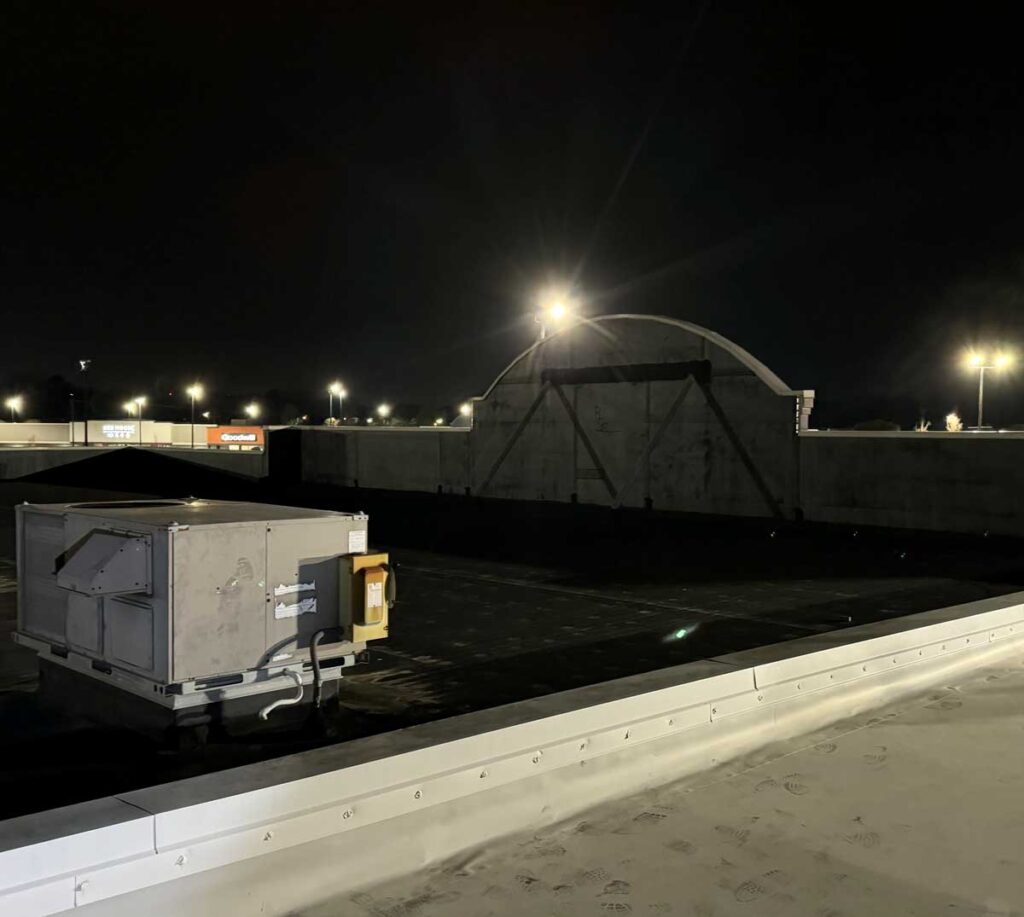

Parapets can come in a variety of heights that can be difficult to estimate from the ground (photo 1 and 2). The presence of roof scuppers can assist in the height estimation of a parapet. Roof scuppers are a drainage system that can range from a hole in the sidewall or a fixture found on a sidewall of a commercial building. This system allows water to run off a flat or sloped roof. Roof scuppers will often be at the same level as the flat or sloped roof and can be viewed from street level. Their placement can offer clues to your height estimation of the parapet. However, scuppers are not always present on buildings for firefighters to use as a reference for height. Another potential roof system obstacle are crickets. At times, crickets are associated with parapets and can further hinder our ability to transition from the aerial to the roof. A roof cricket is a roof system that diverts water to areas of drainage (photo 3). In our area, roof crickets can be found on commercial buildings and possess a large void space behind them up to the parapet. With no presence of scuppers and no prior knowledge of the roof system, how do we transition from the aerial tip, over the unknown parapet height and/or cricket, and to the roof?
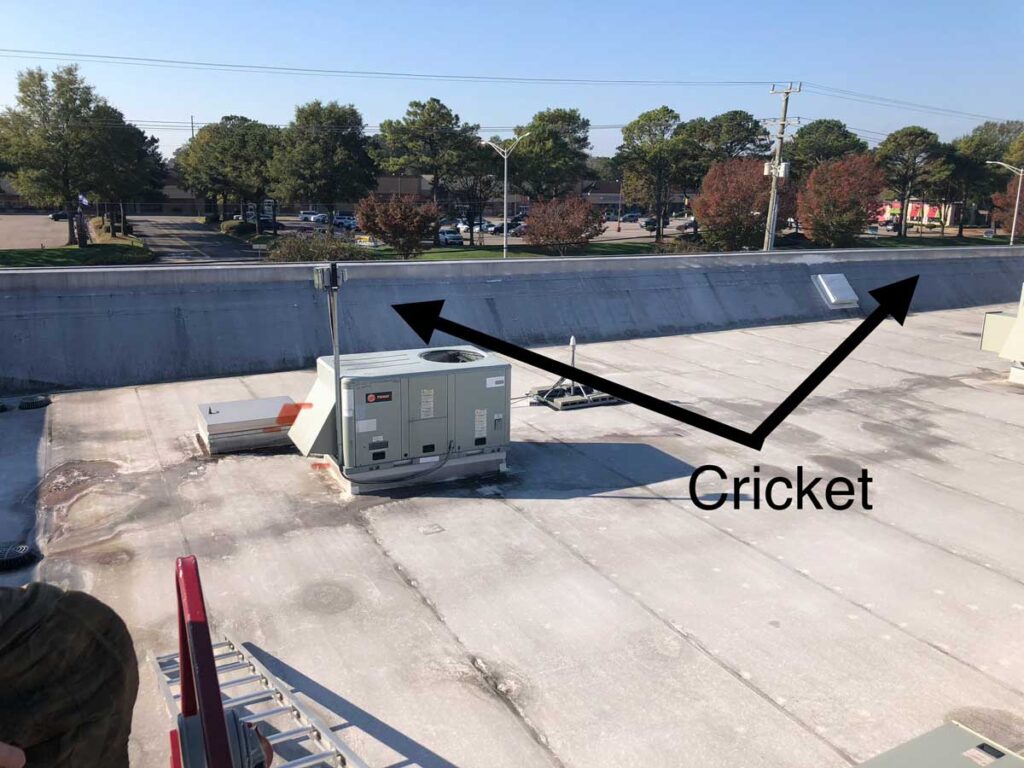
Many newer platform/tower ladders have a parapet system where a roof ladder can be locked or pinned off the front or side of the platform for members to climb down to the roof (photo 4). Aerials do not possess such a system. An obvious option to many would be to use the building’s interior roof access, such as the scuttle hatch or bulkhead, to bypass the parapet. This is certainly a viable option depending on the nature of the call and the accessibility to the roof access for members. If your mission to the roof is to investigate a HVAC roof top unit (RTU) or simply provide a roof report to the incident commander, the interior roof access is an option at your disposal. However, if your mission to the roof is under any suspicion of smoke or fire in the building or confirmed fire, use caution in employing the interior roof access. A firefighter using an interior stairway to roof access or roof scuttle can find themselves in the precarious position of being trapped above the fire should they be overrun. In most cases, especially any suspicion of smoke or fire, I prefer to bypass the interior roof access in favor of our aerial. In my experience, the interior roof access, the scuttle hatches in particular, are usually blocked by storage or the hatch is locked and—you guessed it—no one on site has the key. More importantly, though, using the aerial provides my team a real-world repetition in setup and aerial work on a building that is in our possession until the incident is mitigated. The act of jumping down from the aerial tip to the roof could be an option, depending on the nature of the call, parapet height, height of the firefighter, and athletic prowess of the members making the roof. In some cases, crews can accomplish the jumping or stepping down to the roof. However, you and your crew can be prone to injury when conducting this maneuver due to the increased load of our gear and self-contained breathing apparatus. Jumping down to the roof is not recommended under fire conditions due to the shock load to a potentially compromised roof system. Deciding to jump or step down to the roof should be based on the above factors, including a thorough size-up of the roof. The act of jumping up and climbing back on the aerial from the roof will be the most cumbersome part for you and your team. If roof access or jumping down from the aerial tip to the roof isn’t a viable option or simply not to your liking, use ground ladders to overcome the parapet or cricket and access the roof. A roof ladder, “Fresno” attic ladder, folding ladder, and a vent-enter-search (VES) ladder are popular options for overcoming parapets and crickets.

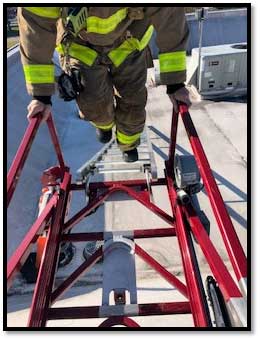
Whatever ladder you choose, it starts with having a plan, knowing your ladder options, and where they are located on your apparatus. In our department, we utilize a 16-foot roof ladder stored outboard on the bed section or a short VES ladder that is stored in our rear ladder tunnel. When assigned to go to the roof of a commercial building, the expectation is the VES ladder comes with us to the roof. This ladder is easy to carry up or set to the side should the parapet prove easy to traverse from the aerial. Should we encounter a higher parapet or a cricket once at the aerial tip, the 16-foot roof ladder is brought to the aerial tip. This ladder will be slid up the aerial beams or carried up, depending on the angle of the aerial. In using the roof ladder, place the hooks over the last rung or second to last rung, depending on your aerial’s construction type. If the aerial doesn’t have K bracing, place the hooks of the roof ladder over the second-to-last rung. Positioning the roof ladder in this fashion will allow for an easier transition from the aerial to the roof ladder. If the aerial has K bracing, place the hooks over the last rung to make your transition to the roof (photo 5). In using the roof ladder, “Fresno” ladder, folding ladder, or VES ladder against the parapet, your best practice will be to place it to the side of the aerial and against the parapet. Doing so allows for an easier transition to the roof for your operation (photo 6 and 7). In photo 6, notice that we placed the 16-foot roof ladder on the parapet and deployed the hooks over the cap. This provides a stable platform for our transition over the cricket to the roof. This placement option tends to be a comfortable method of transitioning from aerial to the roof for most individuals.
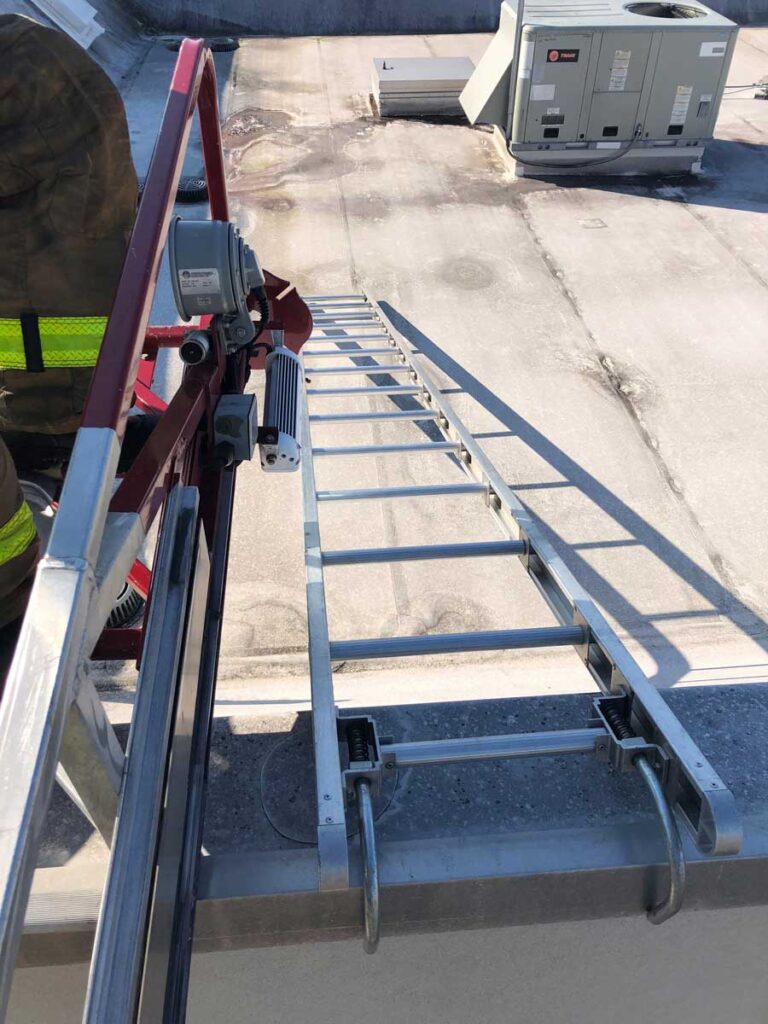
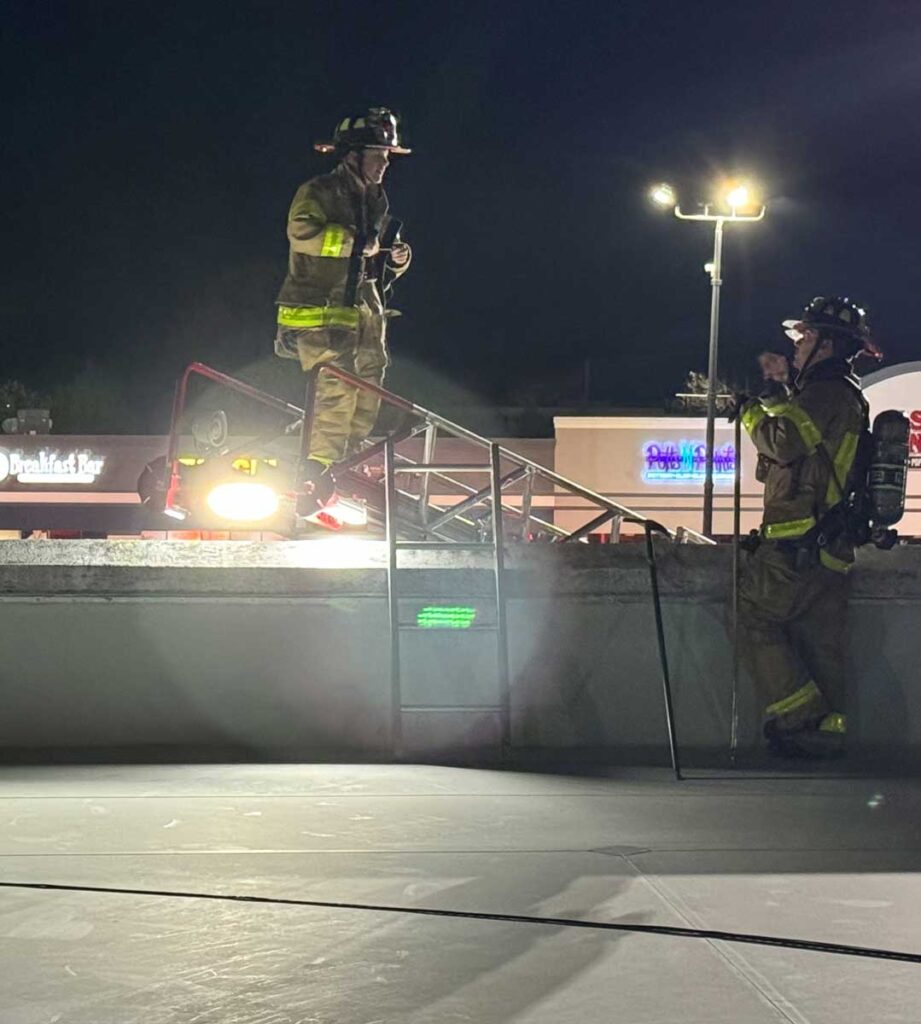
A few important considerations when placing your ground ladders on the aerial or against the parapet.
- Ensure you trust the parapet that you are going to lean the ladder on and place your body weight against during the transition to the roof. Evaluate the caps of the parapet to ensure they are secure and that you trust it to handle the weight or roof hooks.
- The ladder that will be placed on the aerial rungs should ideally be a roof ladder. The roof ladder possesses hooks that will prevent the ladder from coming off the rungs as the aerial bounces during your transition process.
- If the fire originated or communicated to the cricket you are traversing, don’t place the ground ladder directly over the portion of the cricket involved or threatened by fire.
- If under fire conditions, size up the roof, evaluate the roof visually, evaluate with a thermal imaging camera, and sound the roof prior to committing the transition from the aerial to the roof.
- Parapet/cricket transitions during night operations will have elevated risks. Personal lights, portable lights, and tip lights will be your friend in these times. The lighting will enhance your ability to size up the roof and help you identify trip or fall hazards while operating on the roof.
A successful parapet/cricket transition operation begins with discussing expectations and training your company based on said expectations. Have a plan in place for such operations and train with your crew on varying roof types. Commercial fire alarms, gas leaks, and HVAC RTU investigations provide great opportunities to execute and evaluate your plan. It further allows your team to evaluate its proficiency or any “work in progress” areas within the task.
Joseph M. Rock is a captain with the Virginia Beach (VA) Fire Department.

